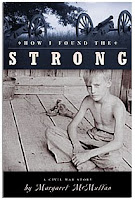 Title: Speak
Title: SpeakBased on the book: Speak, by Laurie Halse Anderson
Year: 2004
Director : Jessica Sharzer
Screenplay: Annie Young Frisbie & Jessica Sharzer
Distributed by: Showtime Networks, Inc.
Running time: 92 min.
Main characters:
Melinda Sordino--played by Kristin Stewart
Joyce, Melinda's mother--played by Elizabeth Perkins
Jack, Melinda's father--played by D.B. Sweeney
Mr. Freeman, art teacher--played by Steve Zahn
It seems like ages since I read the book, Speak, nearly 6 weeks ago because I've read so many books in between, but seeing the movie reinforced my appreciation of the book (click here for my book review.) I thought that the movie stayed pretty true to the book for the most part, leaving out some subplots and other details. However, the major difference between the book and the movie, for me, was the change in the "scene of the crime." In the book, it happened on a walk in the trees nearby where the party was taking place, but in the movie, it happened in a car. It is my understanding that this change was due to the actress' allergy to grass, but I felt like the change of location was detrimental for a couple reasons. First, the walk in the woods scene gave more credibility to Melinda's innocent role than a trip to the car. Secondly, the woods offered a symbolic connection with Melinda's art focus for the year--trees. All in all, I felt like the filmmakers did a wonderful job portraying Melinda's sense of isolation and blended narration, flashbacks, and sequential action. The book contains, of course, significantly more narration, which gives a better picture of what is going on in Melinda's head, and I do think that the film could have used a little more of this narration.
Regarding the acting, I did think that Kristin Stewart was perfect for the role; she plays the quiet, thoughtful, observant, angst-ridden teen very well. I loved Steve Zahn's character, the art teacher, whose role in the book was not quite as colorful but equally significant in terms of Melinda's transformation. I appreciated some of the emphasis on visual elements that were possible in this medium, such as the repetitive imagery of Andy's hand over the Melinda's mouth, to keep her quiet, and again with Melinda's "former" friend Rachel. I felt that the turningpoint for Melinda was more clear in the movie, with emphasis on the art teacher's advice, "If something's eating at you, you gotta find a way to use it." He was talking about artistic expression and more. I felt like the influence art had on Melinda was a little more emphasized in the movie, but I loved this. In the book, she also found confidence when she found she was good at tennis, but this was not emphasized in the movie. I thought the movie did a good job portraying moments where you think Melinda is on the verge of saying something, speaking out, but most of the adults were either oblivious or simply not receptive. Melinda's introspective jaunts to the hospital for rest or to the closet or feeling the wind on her face underscore her artistic nature, preferring the sensory approach to the world rather than the verbal one and help us understand why she chose not to speak out. If I had to say which was better, of course the book would win, hands down, but I must also say that adding the movie to the experience of reading the book has enriched it, added color and life and art to the medium of text.



